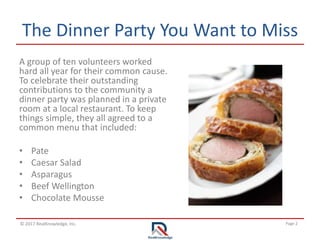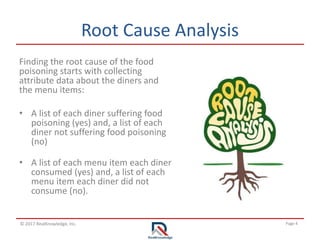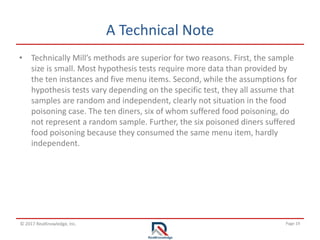Using Attribute Data for Root Cause Analysis: The Dinner Party You Want to Miss
- 1. © 2017 RealKnowledge, Inc. Using Attribute Data for Root Cause Analysis The Dinner Party You Want to Miss Scott Leek Continuous Improvement Leader & Coach
- 2. Page 2© 2017 RealKnowledge, Inc. The Dinner Party You Want to Miss A group of ten volunteers worked hard all year for their common cause. To celebrate their outstanding contributions to the community a dinner party was planned in a private room at a local restaurant. To keep things simple, they all agreed to a common menu that included: • Pate • Caesar Salad • Asparagus • Beef Wellington • Chocolate Mousse
- 3. Page 3© 2017 RealKnowledge, Inc. The Problem Much to the group’s dismay, six of the volunteers developed food poisoning. A root cause investigation is initiated to discover the source of the food poisoning. The investigation intends to answer the following: • Which menu item is the source of the food poisoning? • What is the pathogen that contaminated the menu item? • What is the vector of infection for the contamination?
- 4. Page 4© 2017 RealKnowledge, Inc. Root Cause Analysis Finding the root cause of the food poisoning starts with collecting attribute data about the diners and the menu items: • A list of each diner suffering food poisoning (yes) and, a list of each diner not suffering food poisoning (no) • A list of each menu item each diner consumed (yes) and, a list of each menu item each diner did not consume (no).
- 5. Page 5© 2017 RealKnowledge, Inc. Root Cause Analysis • Data analysis is conducted using a simple set of methods developed by John Stuart Mill.* The methods are: – Method of agreement – Method of difference – Joint method of agreement & difference. • Not only do these methods work, but they have the added benefits of being simple and graphical, only requiring a simple set of tables using color coding (Note: Mill obviously did not have the benefit of spreadsheets and the attendant color coding). • After identifying the offending menu item, further analysis is required on the specific pathogen causing the illness, and the vector of infection.
- 6. Page 6© 2017 RealKnowledge, Inc. Organizing the Data The data are organized in a simple table: 1. The instances and non-instances of food poisoning are setup in the rows, each row is represented by a diner 2. The menu items are setup in the columns 3. The phenomenon (food poisoning) is placed in the right most column 4. The table is populated with “yes” when the menu item is consumed, or when the food poisoning is present 5. Cells are left blank when the menu item or food poisoning was not present (no) 6. The menu items are sorted in descending order from right to left based on the frequency of occurrence (yes)
- 7. Page 7© 2017 RealKnowledge, Inc. The Data Table Instances Caesar Salad Pate Beef Wellington Asparagus Chocolate Mousse Food Poisoning Trish Yes Yes Yes Yes Yes Yes Petra Yes Yes Yes Yes Randy Yes Yes Yes Kumar Yes Yes Yes Yes Patty Yes Yes Yes Edward Yes Yes Yes Yes Yes Prunella Yes Yes Yes Jake Yes Yes Yes Yes Yes Gracie Yes Yes Yes Yes Mitch Yes Yes Yes Yes Yes
- 8. Page 8© 2017 RealKnowledge, Inc. Method of Agreement • The method of agreement is one of Mill’s methods of scientific induction. Quoting Mill on the method of agreement: “If two or more instances of the phenomenon under investigation have only one circumstance in common, the circumstance in which alone all the instances agree, is the cause (or effect) of the given phenomenon.” • In terms of the food poisoning investigation, this means that if one of the menu items is perfectly correlated with the occurrences and nonoccurrences of food poisoning, it is the likely cause.
- 9. Page 9© 2017 RealKnowledge, Inc. Method of Agreement Instances Caesar Salad Pate Beef Wellington Asparagus Chocolate Mousse Food Poisoning Trish Yes Yes Yes Yes Yes Yes Petra Yes Yes Yes Yes Randy Yes Yes Yes Kumar Yes Yes Yes Yes Patty Yes Yes Yes Edward Yes Yes Yes Yes Yes Prunella Yes Yes Yes Jake Yes Yes Yes Yes Yes Gracie Yes Yes Yes Yes Mitch Yes Yes Yes Yes Yes # Agree 10 4 4 6 6 # Disagree 0 6 6 4 4 Agree in the negativeAgree in the affirmative Disagree in the affirmative or negative
- 10. Page 10© 2017 RealKnowledge, Inc. Method of Agreement Instances Caesar Salad Pate Beef Wellington Asparagus Chocolate Mousse Food Poisoning Trish Yes Yes Yes Yes Yes Yes Petra Yes Yes Yes Yes Randy Yes Yes Yes Kumar Yes Yes Yes Yes Patty Yes Yes Yes Edward Yes Yes Yes Yes Yes Prunella Yes Yes Yes Jake Yes Yes Yes Yes Yes Gracie Yes Yes Yes Yes Mitch Yes Yes Yes Yes Yes # Agree 10 4 4 6 6 # Disagree 0 6 6 4 4 A quick scan of the Method of Agreement table leads to the following conclusions: • All ten diners ate Chocolate Mousse but four did not get sick • Eight diners ate Asparagus but three did not get sick, one got sick who did not eat Asparagus • Six diners ate Beef Wellington but three did not get sick, three got sick who did not eat Beef Wellington • Six diners ate Pate but three did not get sick, and three got sick who did not eat Pate
- 11. Page 11© 2017 RealKnowledge, Inc. Conclusion: Method of Agreement Instances Caesar Salad Food Poisoning Trish Yes Yes Petra Randy Kumar Yes Yes Patty Edward Yes Yes Prunella Jake Yes Yes Gracie Yes Yes Mitch Yes Yes • Only the Caesar Salad is perfectly correlated with the instances of food poisoning: – All six instances when diners consumed the Caesar Salad, they also suffered food poisoning – All four instances when diners did not consume the Caesar Salad, they did not suffer food poisoning • Due to the perfect correlation, there is a reasonably high degree of belief that the Caesar Salad is the cause of the food poisoning.
- 12. Page 12© 2017 RealKnowledge, Inc. The Method of Difference The method of difference is another one of Mill’s methods of scientific induction. Quoting Mill on the method of difference: “If an instance in which the phenomenon under investigation occurs, and an instance in which it does not occur, have every circumstance save one in common, that one occurring only in the former; the circumstance in which alone the two instances differ, is the effect, or cause, or a necessary part of the cause, of the phenomenon.”
- 13. Page 13© 2017 RealKnowledge, Inc. The Method of Difference • In terms of the food poisoning investigation, we compare one observed instance of when the problem occurred, with a “nearly similar” instance when the problem did not occur. The menu item causing the food poisoning should be present in the instance when the poisoning occurred, and not present in the nearly identical instance when it did not occur. • Examining the Method of Difference table, we see that Trish’s and Petra’s choice of menu items are nearly identical. Trish consumed every item on the menu, while Petra consumed every item except for the Caesar Salad. Therein lies the difference. The fact that Trish suffered food poisoning and Petra did not, provides further evidence implicating the Caesar Salad. Instances Caesar Salad Pate Beef Wellington Asparagus Chocolate Mousse Food Poisoning Trish Yes Yes Yes Yes Yes Yes Petra Yes Yes Yes Yes
- 14. Page 14© 2017 RealKnowledge, Inc. Joint Method of Agreement & Difference • If the method of agreement or the method of difference implicates the Caesar Salad, there is a reasonable degree of belief to suspect the Caesar Salad is the source of the food poisoning. • The fact that the methods of agreement and the method of difference both implicate the Caesar salad, increases the degree of belief that the Caesar Salad is the source of the food poisoning. • Mill called the consistent finding of both methods, the joint method of agreement and difference.
- 15. Page 15© 2017 RealKnowledge, Inc. Drilling Down to Root Cause • Using the method of agreement, method of difference, and the joint method of agreement and difference, the cause of the food poisoning is narrowed down from five menu items to one, the Caesar Salad. • The root cause however, is still unknown. Two additional questions require investigation: 1. What is the pathogen that contaminated the Caesar Salad? 2. What is the vector of infection for the contamination? • Answering the first question requires testing the Caesar Salad in a laboratory for common pathogens (e.g., E.coli, Listeria, etc.). Assuming the laboratory tests reveal that Listeria is the pathogen, the next level of investigation focuses on discovering the vector of infection for the contamination. Once that is known, the root cause is near, or at hand. Whether the former or latter depends on the degree of belief required in the answer.
- 16. Page 16© 2017 RealKnowledge, Inc. Summary In this case study, attribute data (menu items consumed) are used to discover the most likely cause of another attribute (suffering from food poisoning). Mill’s methods of agreement, method of difference, and joint method of agreement and difference are used to narrow down the potential causes for further investigation.
- 17. Page 17© 2017 RealKnowledge, Inc. A Technical Note • Some practitioners are eager to suggest a more “vigorous” method to analyze the data, using for example, some type of hypothesis test. This is questionable for three reasons: – Context – Approach – Technicality • Contextually this case is an analytic study, not an enumerative study.** The purpose of an analytic study is to understand a dynamic system of cause and effect. The understanding is used to act on the system to improve future outcomes. The essence of an analytic study is the “problem of prediction,” that is, future outcomes.
- 18. Page 18© 2017 RealKnowledge, Inc. A Technical Note • The purpose of an enumerative study is to describe a static population. The description is used to act on the population described, not on future outcomes. Clearly the purpose here is to prevent future outbreaks of food poisoning, not describe the six diners suffering food poisoning. Thus, this is an analytic not enumerative study therefore hypothesis tests are not appropriate. • In any situation, the simplest approach to answer the questions at hand, are most desirable. Mill’s methods fit this bill. They are simple enough for anyone who can create a table of results. The analysis is also simple, requiring no more than a tally of results in four categories (i.e., consumed and got sick, consumed and did not get sick, did not consume and got sick, did not consume and did not get sick).
- 19. Page 19© 2017 RealKnowledge, Inc. A Technical Note • Technically Mill’s methods are superior for two reasons. First, the sample size is small. Most hypothesis tests require more data than provided by the ten instances and five menu items. Second, while the assumptions for hypothesis tests vary depending on the specific test, they all assume that samples are random and independent, clearly not situation in the food poisoning case. The ten diners, six of whom suffered food poisoning, do not represent a random sample. Further, the six poisoned diners suffered food poisoning because they consumed the same menu item, hardly independent.
- 20. Page 20© 2017 RealKnowledge, Inc. About the Author Scott is a Continuous Improvement Leader & Coach, and the CEO of RealKnowledge, Inc. He has more than 30 years of experience helping leaders and coaching practitioners in the improvement arts and sciences. Scott can be contacted here.
- 21. Page 21© 2017 RealKnowledge, Inc. Footnotes * Mill’s methods are outlined in “A System of Logic,” 1843. ** Deming, W. Edwards, “On Probability as a Basis for Action,” The American Statistician, Vol. 29, No. 4, 1975, pp. 146 – 152.
- 22. Page 22© 2017 RealKnowledge, Inc. Credits • Icons below used in the presentation made by Freepik from Flaticon are licensed under Creative Commons BY 3.0
- 23. © 2017 RealKnowledge, Inc. Using Attribute Data for Root Cause Analysis The Dinner Party You Want to Miss Scott Leek Continuous Improvement Leader & Coach























